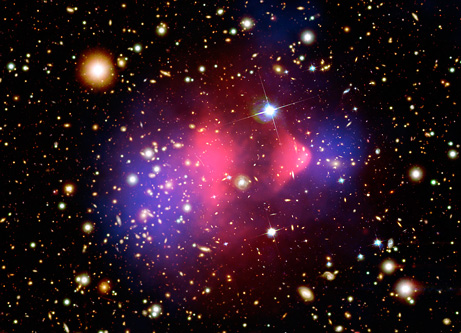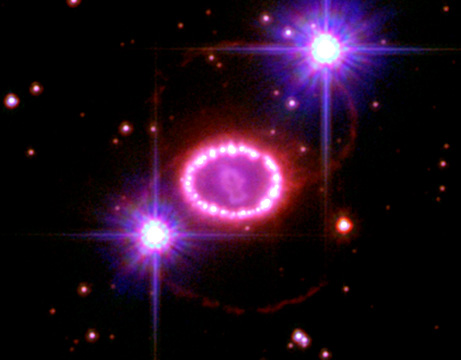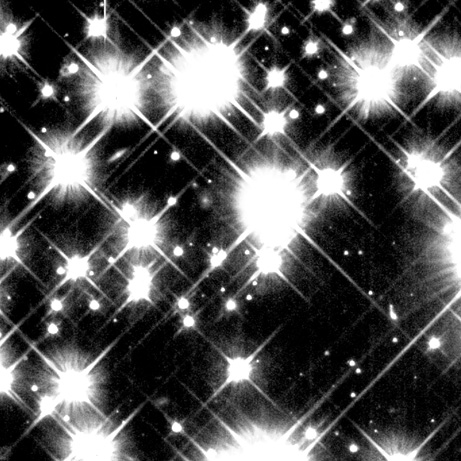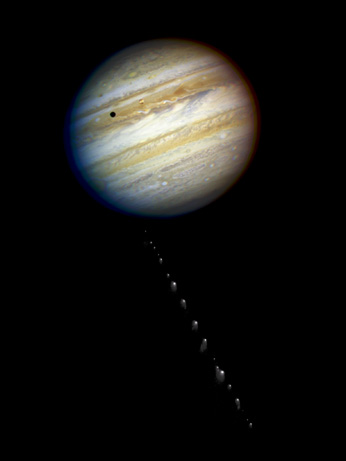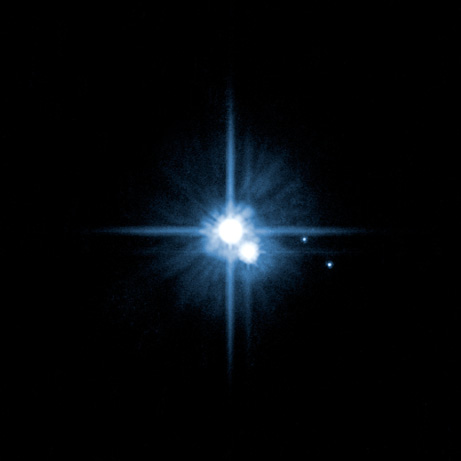First Direct Proof of Dark Matter(暗物质)
Whirling around Earth at 17,500 miles (28,163 kilometers) an hour, the Hubble Space Telescope(哈勃空间望远镜) has captured some of the most detailed pictures yet of space objects and activities.
But Hubble is about much more than pretty pictures. Using its data, researchers have made giant leaps in(在某方面取得跨越式进展) unraveling(拆开) mysteries of the universe.
In honor of the telescope's 19th birthday--April 24, 2009--NASA has released its list of the top 12 science discoveries made using Hubble pictures, including this picture of the so-called Bullet Cluster.
Combined with(结合) data from two other telescopes, Hubble's view of the cluster shows what happens when two large groups of galaxies(星系) collide(碰撞). The image was hailed in 2006 as the first direct proof of dark matter, a still unidentified substance thought to make up most of the total mass of the universe.
"Cosmic Pearls" Found Around Supernova(超新星)
Although supernova 1987A was first spotted two decades ago, Hubble is the only existing observatory(天文台) that can make out each "bead" in the dead star's unusual "necklace," as seen in this December 2006 picture.
Pink material in the middle of the ring is debris(残骸) left behind when the massive star exploded. Astronomers think the ring is an outer layer of matter that the star had shed 20,000 years before it died. The shock wave(冲击波) from the blast is now heating up regions of that ring, creating the glowing "pearls."
The two bright objects outside the ring are nearby stars.
Guessing the Age of the Universe
Resembling a firefly(萤火虫) festival, this 2002 Hubble picture of old white dwarf stars(白矮星) helped astronomers pinpoint(准确地找出) the age of the universe with unprecedented(史无前例的) accuracy.
White dwarfs are the dense(稠密的) cores left behind when sunlike stars die. Measuring the light from some of the oldest known white dwarfs revealed that the burned-out stars are 12 to 13 billion years old.
Since then, astronomers have combined these data with age estimates from a theoretical model(理论模型) of the expansion of the universe, as well as more recent measurements of the diffuse radiation released just after the big bang(宇宙大爆炸).
Scientists now say with confidence that the universe is 13.7 billion years old, plus or minus a few hundred thousand years.
Jupiter(木星) Takes a Beating
Two Hubble images stitched together show a "train" made up of bits of comet P/Shoemaker-Levy 9 taking aim at(瞄准) Jupiter in May 1994--a month before about 20 pieces of the dying comet slammed into(猛烈攻击) the gas giant's southern hemisphere(南半球).
The planet survived the assault relatively unscathed(未受伤的), even though each hit generated the same amount of energy as would be released if all the atomic bombs on Earth exploded at the same time.
Pluto(冥王星) Gains Some Pals
In 2005 Hubble spotted two faint moons around Pluto, bringing the former planet's orbital(轨道的) partners up to three. Previously Pluto's only known moon had been Charon--the large body seen next to Pluto in the above image--which was discovered in 1978.
Dubbed(被称作) Nix and Hydra, the two newer moons are about 5,000 times fainter than Pluto.
In a bit of a mixed blessing, Hubble also played a part in demoting(降级) Pluto to its current status as a dwarf planet (except in Illinois on March 13, 2009). Hubble pictures helped astronomers realize that one of Pluto's neighbors, Eris, is a larger body, kicking up(引起) a lively debate about what defines a planet.


